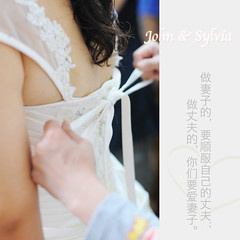| The White Wedding Dress (Photo credit: teresachin2007) |
Traditional Beliefs in the Wedding Dress Color
The following is a short rhyme about traditional views on how the color of the wedding dress determines the bride's future. Of course, this is just for fun and there's no truth to the predictions.
| Married in White | You have chosen right. |
| Married in Blue | Your lover is true. |
| Married in Pink | Your fortunes will sink. |
| Married in Green | You will not long be seen. |
| Married in Red | You'll wish you were dead. |
| Married in Yellow | Ashamed of the fellow. |
| Married in Brown | You'll live out of town. |
| Married in Grey | You'll live far away. |
| Married in Black | You'll wish you were back. |
The Bride Shouldn't Make Her Own Wedding Dress
Though the bride saves money from buying a wedding dress, when she makes it herself despite her dressmaking skills, she's told that throughout her marriage she'd be shedding a tear for every stitch she makes on that dress.
Wearing the Wedding Dress Before the Wedding Day is Forbidden
The old wives say that a bride who puts on her wedding dress before the Date brings bad luck to the event and possibly to her marriage. The worst urban legends even go as far as claiming that breaking this tradition results to death for either the bride or groom.
The Wedding Dress Has Always Been Ivory or Virginal White
It was Queen Victoria who made white wedding dresses popular in the 1800s because white is strongly associated with purity and modesty - two of the most desirable traits in a young virgin. The Queen preferred the symbolism of a white wedding dress over the traditional silver of Royal wedding outfits. Before that era, brides just wore the best dress they ever had in their chest or closet. Naturally, these women's wedding dresses would have other colors besides white.
On the couple's special day, the bride's wedding dress often becomes a major part of the event (if not THE main event). The dress attracts so much attention from guests that they had to find out who its designer was, what materials were used, and who were the artisans who handcrafted the beading and embroidery. These days the color doesn't really matter. Some brides have worn red, blue, yellow, or even black on their wedding day. And, one more thing: there's actually no difference between a plus size wedding dress and the regular-sized ones in their cut and style.

There are certain things have to look for picking the bridal dress for the wedding. To search for the best vendors nearby area, the brides may use the free wedding app and wedding planning website will be helpful for them.
ReplyDelete